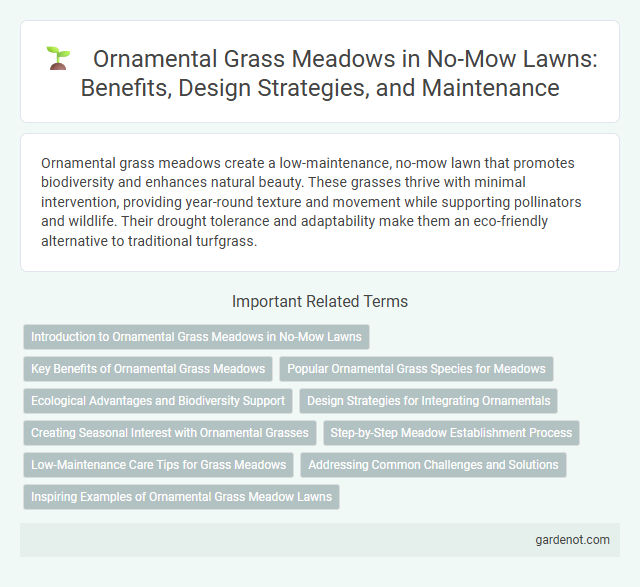Ornamental grass meadows create a low-maintenance, no-mow lawn that promotes biodiversity and enhances natural beauty. These grasses thrive with minimal intervention, providing year-round texture and movement while supporting pollinators and wildlife. Their drought tolerance and adaptability make them an eco-friendly alternative to traditional turfgrass.
Introduction to Ornamental Grass Meadows in No-Mow Lawns
Ornamental grass meadows in no-mow lawns offer a sustainable, low-maintenance alternative to traditional turfgrass by incorporating diverse species like Miscanthus, Feather Reed Grass, and Blue Fescue. These meadows enhance biodiversity, support pollinators, and improve soil health with deep root systems that reduce erosion and increase water retention. By reducing mowing frequency, property owners benefit from lower carbon emissions and maintenance costs while creating aesthetically pleasing, natural landscapes.
Key Benefits of Ornamental Grass Meadows
Ornamental grass meadows enhance biodiversity by providing habitat for pollinators and beneficial insects, promoting a healthier ecosystem. These meadows require minimal mowing, reducing maintenance time and lowering fuel consumption, which cuts carbon emissions. Their deep root systems improve soil structure and water retention, contributing to drought resilience and soil health.
Popular Ornamental Grass Species for Meadows
Ornamental grass meadows enhance no-mow lawns by incorporating popular species like Miscanthus sinensis, Calamagrostis x acutiflora, and Pennisetum alopecuroides, known for their texture and seasonal interest. These grasses provide ecological benefits such as habitat for pollinators and improved soil health while requiring minimal maintenance. Selecting diverse species with varying heights and bloom times ensures year-round visual appeal and sustainability in ornamental grass meadows.
Ecological Advantages and Biodiversity Support
Ornamental grass meadows in no-mow lawns provide essential habitats for pollinators, birds, and beneficial insects, boosting local biodiversity. Their deep root systems improve soil health by enhancing water retention and reducing erosion. These meadows also sequester carbon effectively, contributing to climate change mitigation.
Design Strategies for Integrating Ornamentals
Incorporating ornamental grass meadows into no-mow lawns enhances biodiversity while reducing maintenance requirements, promoting sustainable landscaping practices. Selecting native and drought-resistant species like Miscanthus sinensis or Festuca glauca ensures year-round visual interest and ecological benefits. Strategic layering and varied textures within the meadow design optimize aesthetics and habitat diversity, creating a dynamic, low-maintenance garden feature.
Creating Seasonal Interest with Ornamental Grasses
Ornamental grass meadows enhance no-mow lawns by providing dynamic seasonal interest through varying textures, colors, and heights. Species like Miscanthus sinensis and Calamagrostis x acutiflora offer vibrant autumn hues and graceful seed heads that sway in the breeze, attracting pollinators. Integrating diverse ornamental grasses extends visual appeal from spring through winter while reducing maintenance needs.
Step-by-Step Meadow Establishment Process
Prepare the soil by removing existing turf and loosening the ground to create an ideal seedbed for ornamental grass meadow seeds. Sow a carefully selected mix of native and drought-tolerant grasses evenly across the prepared area, ensuring optimal seed-to-soil contact for strong germination. Maintain the meadow by watering regularly during the initial establishment phase and mowing sparingly to encourage deep root growth and natural meadow development.
Low-Maintenance Care Tips for Grass Meadows
Ornamental grass meadows offer a stunning, eco-friendly alternative to traditional lawns with minimal upkeep required. Regularly cutting the grass once or twice a year, preferably in early spring or late fall, promotes healthy growth and prevents thatch buildup. Ensuring adequate watering during dry spells and occasional removal of invasive weeds helps maintain a vibrant, low-maintenance meadow thriving in various soil types.
Addressing Common Challenges and Solutions
Ornamental grass meadows in no-mow lawns require careful selection of drought-tolerant and low-maintenance grass species to address common challenges like uneven growth and weed invasion. Implementing proper soil preparation and targeted mulching reduces nutrient competition and promotes healthy root development. Regular monitoring and selective trimming help maintain aesthetic appeal while preserving the meadow's natural ecosystem.
Inspiring Examples of Ornamental Grass Meadow Lawns
Ornamental grass meadow lawns showcase a diverse range of species like Festuca glauca, Miscanthus sinensis, and Calamagrostis x acutiflora, creating visually dynamic landscapes that enhance biodiversity and require minimal mowing. These meadows provide year-round texture and movement, attracting pollinators such as bees and butterflies while reducing maintenance costs and water usage compared to traditional lawns. Examples from residential and public gardens demonstrate how integrating native grasses with wildflowers results in sustainable, resilient green spaces that support local ecosystems.
Ornamental grass meadow Infographic

 gardenot.com
gardenot.com